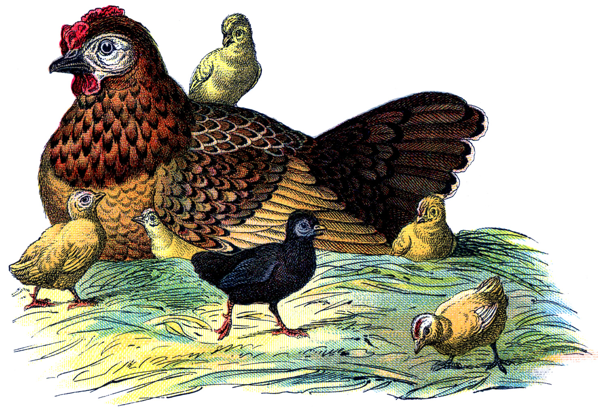Poultry Motifs

Animal symbols on pysanky can have a variety of meanings. According to Marusia Chaika, they can represent different levels of the universe, different attributes of the Berehynia, or be meant to have an influence on the fertility of a household’s own animals.
Poultry are first and foremost birds, and birds are what links us to the heavens. They are messengers from a higher plane. Birds are also solar symbols, especially roosters, who greet the sun at dawn. And chickens , ducks and geese are an important part of any village household; their contented fertility was important to a household’s survival and future prosperity.
In Ukrainian folk pysankarstvo it is typical to depict only the most characteristic features of an animal, rather than the entire animal. Often this results in only “heads and paws” being depicted. While chickens are sometime portrayed whole on pysanky, ducks and geese almost never are. They are usually represented by their feet or, less commonly, their necks.


Many of what we now consider to be “feet” may have had earlier meanings that were lost over time, and the symbols renamed. Some scholars consider these symbols to be versions of the lotus or trident. These same symbols may, in different regions, be interpreted as leaves or plants.

Other bird feet apear to be the same symbol as the “hand of god” symbols which date back to the Paleolithic era. Such symbols usually have three or sometimes four fingers–but not five. This can be explained because to early people the god-sun was seen as a bird, and his handprint would thus by the print made by the feet/talons of a bird. Note the similarity of this motif to those called "chicken feet," “duck feet” or "magpie feet."

Representations of bird parts (eyes, feet, beaks, combs, feathers), of course, carry the same meaning as the entire bird. These two pysanky are examples, from Kyivshchyna, of «курячі лапи» (chicken feet) and «качачі лапки» (duck feet) on a pysanka:


These pysanky present different examples of duck’s feet: from the left from Lvivshchyna, and on the right from Podillia (Yavoriv village, Pishchany raion, Vinnytsia oblast).


Chickens can sometimes can also be seen whole, as on the two Hutsul pysanky on the left. The pysanka on the right is from Kosmach, and has on it ducklings («каченята»).



This pysanka from Binyashvsky is called by him «Качур» (drake, male duck), but that may have been a later reinterpretation. The design is from Western Podillia, and is actually a curl with wings. It is more likely a serpent motif that was renamed much later.

Moszynski tells us that the ancient Slavs believed that navy, the souls of those who died unbaptized, left bird tracks in the ashes. Navy were portrayed as giant, featherless roosters, and they were said to attack pregnant women and children, sucking their blood, and to drink the milk of cattle. Their screams and singing meant imminent death. Charms against them included salt, fire or an axe.

(Above: pysanka from Boroviivka, povit Kursk)
Chickens, Ducks, Geese






